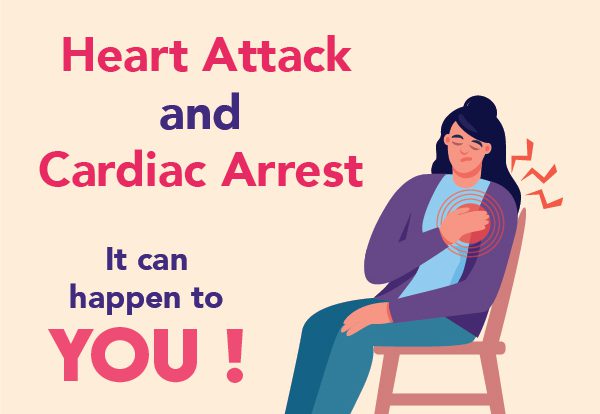
In recent times, heart-related health conditions have become a common concern for people globally. But still, people do not have the basic information and awareness. The two most common heart problems we hear about are heart attack and cardiac arrest. Although heart attack and cardiac arrest appear to be similar, they are two different things. Let us take a closer look at the difference between heart attack and cardiac arrest and understand the symptoms and treatment options for each. We hope this information helps you. Stay healthy!
HEART ATTACK:
A heart attack is an interruption in the blood supply of the heart caused by a blocked artery which might cause damage to one particular area of the heart. This can happen when one or more of the heart’s arteries becomes narrow or blocked, usually as a result of a build-up of plaque. Plaque is a collection of blood-borne components, including fat, cholesterol, and others. A heart attack can also occur if a blood clot forms on top of a plaque, completely blocking the artery. Heart attacks can be fatal, but prompt treatment can save lives and often minimize damage to the heart.
SYMPTOMS OF HEART ATTACK:
Symptoms of a heart attack include chest pain or pressure, shortness of breath, sweating, nausea, and lightheadedness. Consult a doctor right away if you have any of these symptoms. When it comes to heart attacks, time is of the essence. Early diagnosis and treatment mean better chances of recovery.
CARDIAC ARREST:
Cardiac arrest is an electrical problem where a sudden electrical disturbance in the heart leads to stopping the functioning of the heart. A Cardiac arrest occurs when the heart suddenly stops beating caused by several factors, including electrical problems in the heart, a heart attack, or extreme trauma. As the heart stops pumping the blood, the lungs, brain and other organs stop receiving the flow of blood and this can lead to brain dead or death if treatment is not provided.
SYMPTOMS OF CARDIAC ARREST:
Cardiac arrest is a medical emergency and the symptoms include loss of consciousness, lack of pulse, and labored breathing. If not treated immediately, cardiac arrest can lead to brain damage and death. Fortunately, cardiac arrests can be treated with CPR and defibrillation devices that restart the heart and restore normal cardiac function.
DIFFERENCE BETWEEN HEART ATTACK AND CARDIAC ARREST:
 It is important to note that cardiac arrest is different from a heart attack, which occurs when blood flow to the heart is blocked. While both cardiac arrest and heart attacks are life-threatening, cardiac arrest is usually more sudden and requires immediate medical attention.
It is important to note that cardiac arrest is different from a heart attack, which occurs when blood flow to the heart is blocked. While both cardiac arrest and heart attacks are life-threatening, cardiac arrest is usually more sudden and requires immediate medical attention.
Heart attack can lead to cardiac arrest, but cardiac arrest can occur in a person suffering from some heart disease or even in a person with a normal and healthy heart and cause death. Cardiac Arrest causes four times the number of deaths caused by heart attacks.
DIAGNOSIS AND TREATMENT:
Doctors use many different techniques to diagnose heart conditions, but one of the most important is the electrocardiogram (ECG). The device measures the electrical activity of the heart and can be used to detect different cardiac problems. One common condition that can be diagnosed with an ECG is Heart Attack.
There are a variety of ECG devices that doctors use to detect heart attacks or cardiac arrest. The most common type of device is the 12-Lead ECG machine which requires electrodes and wires to be placed on your body (chest) to measure the electrical activity of the heart from different points of the body to detect any problem in the heart including a heart attack. ECG can reveal disturbances in heart rhythm, or abnormal electrical patterns, such as prolonged QTc interval that increases the risk of sudden death.
When a Cardiac arrest happens, the doctor might advise the patient to take regular ECGs to find out the causes caused Cardiac arrest to avoid any future episodes.
Other types of devices include Pocket ECG devices which can be kept in a pocket and used for regular monitoring of ECG anytime, anywhere. These devices do not necessarily need electrodes to be attached to the body. They are wireless and use dry electrodes to record the electrical activity of the heart and display a graphical image of ECG on a smartphone. The ECG reports can be shared with a doctor via mobile phone, who can provide diagnosis and treatment. Other types of ECG devices available are Holter monitors, event monitors, and implantable cardiac defibrillators. Each type of device has its unique features and benefits, and doctors will often use multiple devices to get the most comprehensive analysis of the patient’s cardiac health. In general, however, all ECG devices work by measuring the electrical activity of the heart and looking for patterns that may indicate a problem. As such, they are an important tool in the diagnosis and treatment of cardiac conditions.
With heart disease being the number one killer in the world, it is essential to have some safeguards. SanketLife ECG devices can be that safeguard for you and your loved ones. This pocket-sized device can take a medical grade 12-Lead ECG just by touching the electrodes. It is connected to a cloud to store your reports and a network of doctors who will give you quick advice if anything seems wrong with your heart. Protect yourself from one of the biggest killers in the world and get a SanketLife ECG device today.
